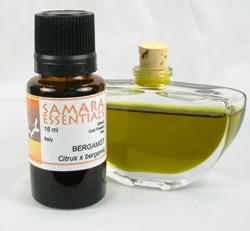
Plant Part: Fruit
Extraction: Cold Pressed
Growing Practice: Ethical
Country of Origin: Italy
Odor Type: CITRUS

Odor characteristic: Odor is light, delicate and refreshing like most citrus. Initial odor is sweet-fruity, followed by an oily-herbaceous, somewhat balsamic body and dryout. Sweetness (presence of large amounts of lyalyl-acetate/linalool and traces of methyl-anthranilate). Yields to a more tobaccolike rich note somewhat like clary sage. The freshness in topnotes mainly due to presence of aliphatic aldehydes. The absence of the oil note can reflect an inferior or adulterated bergamot oil. Leaves are alternate, simple, palmately compound and white flowers are sweet scented, always bisexual.
Refractive Index: 1.45900 to 1.46790 @ 20.00 °C.
Specific Gravity: 0.86200 to 0.87000 @ 25.00 °C.
Appearance: green or olive green, mobile liquid
BioChemical Class: Ester, monoterpenes, alcohol
CAS No: 8007-75-8
INCI Name: CITRUS BERGAMIA PEEL OIL EXPRESSED
About the Plant
Citrus aurantium subsp. Bergamia is a small evergreen tree from the Rutaceae family, a cross between pear lemon and Seville orange. The fruits are inedible and are raised for the oil they produce, which is expressed from the peel. The tree is cultivated in a narrow coastal strip in southern Calabria, Italy. Cultivation in other areas have failed to produce bergamot oil that compares to that from this region.Excellent Citrus Reference: http://users.kymp.net/citruspages/introduction.html
In biology, a genus (plural genera) is a grouping in the classification of living organisms having one or more related and morphologically. Citrus is a common term and genus of flowering plant in the Family Rutaceae, originating in tropical and subtropical Asia. The genus contains three species and numerous natural and cultivated origin hybrids, including commercially important fruit such as the orange, lemon, grapefruit, lime, and tangerine. The taxonomy of the genus is complex, but recent genetic evidence (see e.g. external link cited below) supports the presence of only three species, C. maxima, C. medica and C. reticulata, with all the other taxa previously accepted as species being of hybrid origin between these three. They are large evergreen shrubs or small trees, reaching 5-15 m tall.
Note: Biotechnology provides new tools that can be used to address questions about the origin and relationships among Citrus taxa. Many Citrus taxa are believed to have originated as hybrids between ancestral species. The International Society for Horticultural Science describe the use of molecular markers to assess the parentage of several putatively hybrid taxa. Seventy-three accessions from 45 Citrus species and twelve accessions from six related genera were examined for restriction fragment length polymorphisms (RFLPs) using 25 probe/enzyme combinations. ISHS wrote a computer program to identify pairs of accessions that could have contributed the bands found in putative hybrid accessions such as C. bergamia, C. jambhiri, and C. limonia. The potential parent/hybrid relationships were then evaluated on the basis of previously existing biochemical, isozyme, morphological, geographical and historical information. The RFLP profile of C. bergamia was fully accounted for by C. aurantium x C. limetta. The profile of C. limonia was fully accounted for by any of six mandarin species x C. aurantifolia or C. macrophylla. Five mandarins x C. medica account for all but one C. limonia band, and C. medica may have stronger geographic credibility than C. aurantifolia. This data set was not strong enough to unambiguously define the ancestors of C. jambhiri because C. limon x three different species could generate the C. jambhiri profile, and C. limon x three mandarins had one mismatch each. Molecular markers provide new evidence about the origin of taxa, but until sufficiently large data sets have been compiled, they cannot be used exclusively to prove parentage but must be balanced with existing information
History
There is not much medicinal lore surrounding Bergamot, however, small boxes were traditionally crafted from the peel, made by shaping the rind around a wooden mandrel or mold. The rind is then painted with motifs, flowers, landscapes or romantic scenes and varnished to grace a dressing table in milady's boudoir.
* Bergamot oil shown to be a potent antifungal in vitro against clinically important Candida species.
http://jac.oxfordjournals.org/cgi/content/full/59/2/305
Perfumery: Used extensively in citrus colognes, chypres, fougeres, modern fantasy bases. It blends with most floral and fruity notes, as well as wood and vanillin notes.
Food and Flavor: Bergamot peel has been used to flavor tea.![]()
The information provided on these pages is not a substitute for necessary medical care, nor intended as medical advice. Always keep aromatic extracts tightly closed and in a cool, dark place, out of reach of children. Never ingest aromatic extracts. Always dilute aromatic extracts when applying topically and avoid areas around eyes or mucous membranes. If redness or irritation occurs, stop using immediately and contact your health provider if necessary.![]()
all images and content copyright ©2000—2020 by suzumebachi design and samara botane





